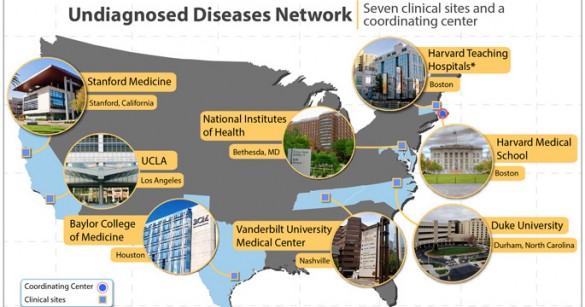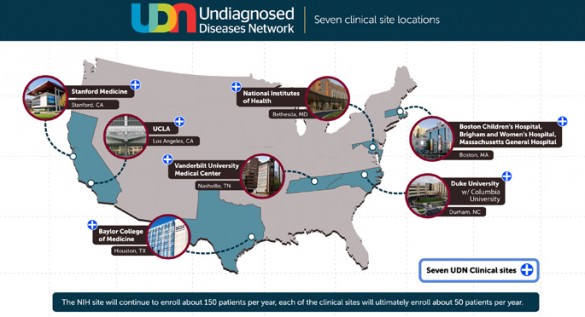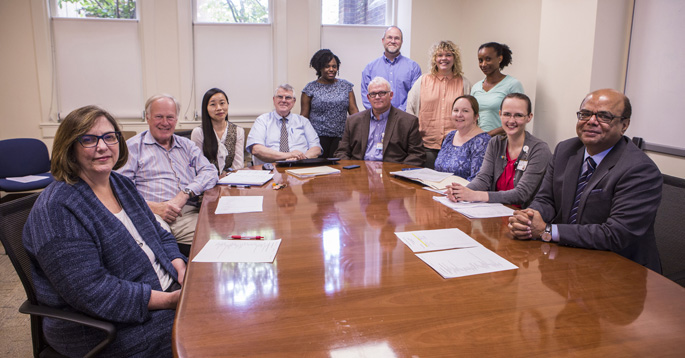Vanderbilt University Medical Center’s Undiagnosed Diseases Network (UDN), part of a clinical research initiative of the National Institutes of Health (NIH), has been funded by the NIH for another four years. The new funding cycle began Sept. 1.
VUMC is one of seven sites around the country selected in 2014 that will continue to participate in a clinical network to develop effective approaches for diagnosing hard-to-solve medical cases (undiagnosed diseases). An additional five sites have been added to this most recent round of funding: University of Washington; Children’s Hospital Philadelphia; Washington University; University of Miami and University of Utah.
The network’s purpose is to bring together clinical and research experts from across the United States to solve the most challenging medical mysteries using advanced technologies.
An undiagnosed disease can be a new disease or a rare presentation of a rare disease. Patients who apply to the UDN sites have not been diagnosed — not because they don’t have something — but because nobody has seen it before.
Over the past four years, the Vanderbilt UDN site has been responsible for about 25 percent of all diagnoses made by the seven sites.
“We were pretty optimistic we’d be good, but I think it surprised us all that we were that good,” said Rizwan Hamid, MD, PhD, Division Chief of Genetic Medicine and Genomic Medicine, Dorothy O. Wells Professor of Pediatrics and Cancer Biology and one of the site’s four principal investigators, along with John Phillips III, MD, professor of Pediatrics, Biochemistry and Medicine and the David T. Karzon Professor of Pediatrics; John Newman, MD, the Elsa S. Hanigan Professor of Pulmonary Medicine, and Joy Cogan, PhD, professor of Pediatrics.
“Our diagnostic (success) rate is more than 50 percent, Hamid said. “That’s a testament to the talent of our team, the resources we have here like BioVU (Vanderbilt’s biorepository of DNA extracted from discarded blood collected during routine clinical testing and linked to de-identified medical records) and the institutional commitment made by our leaders some time ago to invest in the intellectual infrastructure that is paying dividends now.”
Through funding from the NIH Common Fund, the 12 sites and four core labs will work together to try to solve medical mysteries through team science.
“With the additional sites, there will not only be more capacity, but geographically, there can be a more even distribution of patients,” Hamid said.
To date, from 2,710 applications, 1,144 patients have been enrolled at the initial seven sites for extensive genetic testing and a two- to five-day visit for a clinical evaluation. Of those accepted, 877 have been evaluated and 225, diagnosed — 51 of those achieved through the Vanderbilt program.
Since September 2015, 362 applications have been referred to VUMC with 141 acceptances resulting in 100 completed evaluations.
The UDN grew out of the success of the Undiagnosed Diseases Program at the NIH Clinical Center in Bethesda, Maryland.
Each site was tasked with seeing 135 patients over the first four years. The infrastructure was set up during the first 20 months and evaluations began sometime during 2016. Over the next four -year grant period all sites will see between 60-120 patients each.
Each UDN site starts the review the same way, with an initial lab report, but beyond that, each goes about evaluating patients in a different way. At Vanderbilt, those accepted consent to clinical testing and genomic sequencing, as well as an extensive inpatient clinical evaluation, which, in many cases, can take five days. The patient’s DNA is analyzed either by whole exome or whole genome sequencing.
“We are getting more efficient with every patient,” Hamid said. “Every month we kind of fine-tune everything. We look at our successes, our failures, our problems and tweak everything.”
Hamid said there are multiple faculty and staff across both the Medical Center and the University involved in VUMC’s UDN. The group includes VUMC’s UDN group (presenting clinical data and data from three sequencing analysis pipelines); Department of Biostatistics; Center for Precision Medicine (phenotype risk scoring); Vanderbilt Center for Structural Biology; and Vanderbilt Genetics Institute (GTEx and PrediXcan).
“It’s all driven by a passion for helping these patients who come to us in search of an answer,” Hamid said. “There’s not enough money in the grant to support all the people here who help us find answers. All of us want to contribute and help the mission of the institution by helping these patients. It’s amazing to see it in action.”















